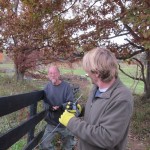Making it permanent….
 We’re confident enough of our “mob grazing” experiment that we’ve installed electric fencing around the perimeter of our two major pastures. In two days, Duane Ard (foreground) and Ira McDowell stretched just about a mile of high tensile wire, three lightning grounding systems and two new energizers. We’re now supplying about 12,000 volts to most sections of the farm.
We’re confident enough of our “mob grazing” experiment that we’ve installed electric fencing around the perimeter of our two major pastures. In two days, Duane Ard (foreground) and Ira McDowell stretched just about a mile of high tensile wire, three lightning grounding systems and two new energizers. We’re now supplying about 12,000 volts to most sections of the farm.
We’ll attach movable, temporary, polywire to the main line and create small sub-paddocks of less than an acre. The idea is to put maximum cow weight—briefly—on small sections of pasture, which ensures even forage consumption and maximum trampling effect. If we get it just right, the cows eat about a third of the grass, grind a third into the ground to create organic matter, and leave at third for rapid regrowth. The plan does require us to move the fencing each day, no matter the weather. (See “A dress rehearsal” below)
We’ve seen quite an improvement in the area of our test project this year. Not only do we have a thicker stand of grass but we’ve been able to set aside just about half the area for the winter. That will save a lot on hay costs. We’ve also saved by not having to spray fertilizer. (We normally use fish oil and kelp, not chemical fertilizer, twice a year.)
Fertilizing pastures and buying hay, which has to be cut, baled, transported and fed, all burns a lot of diesel. And we’re not only cutting costs but also doing a lot less damage to the environment. Coupled with our water conservation program, which won an award from the State, Thistle Hill is as “eco-friendly” as any farm we know.